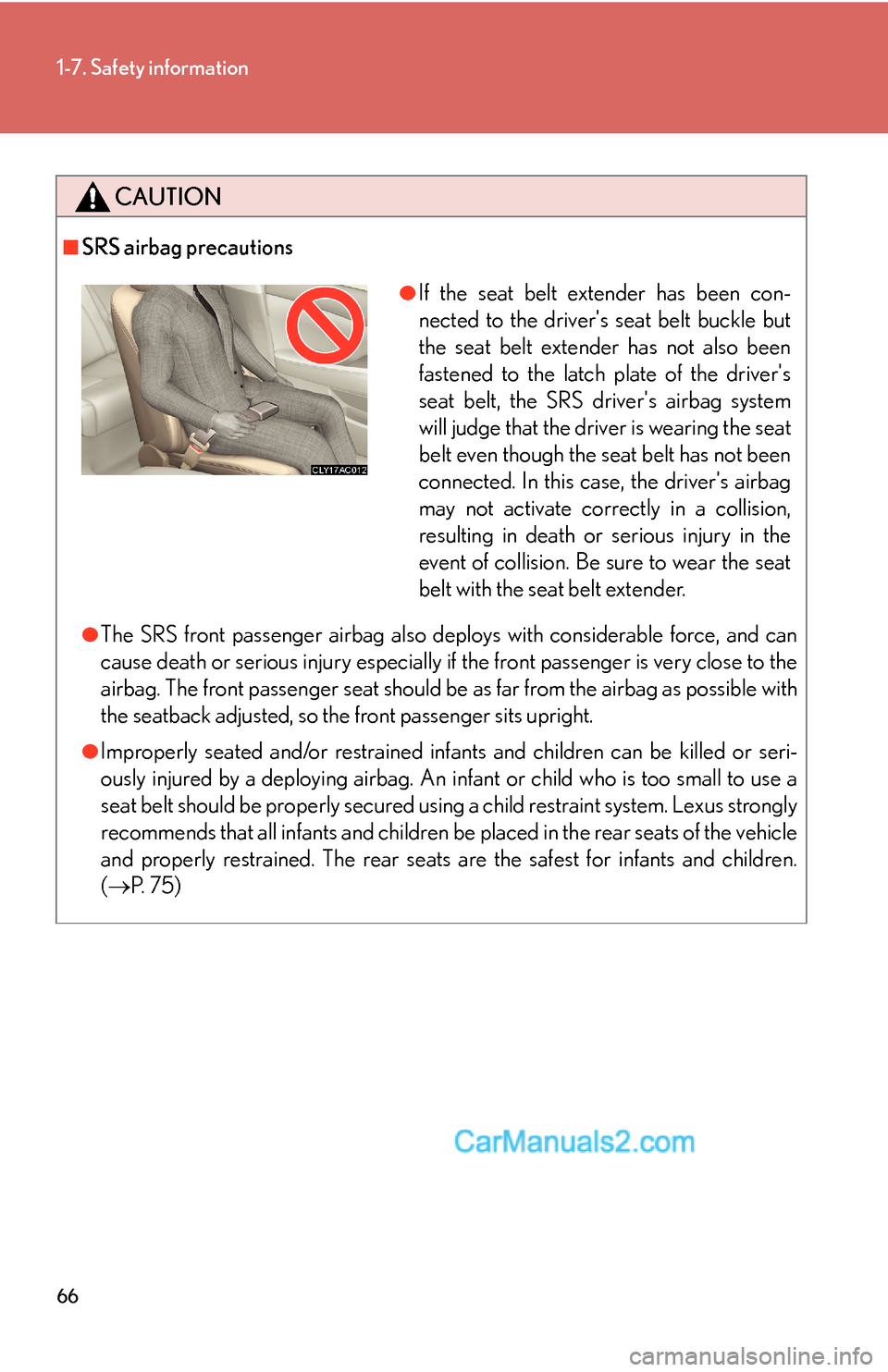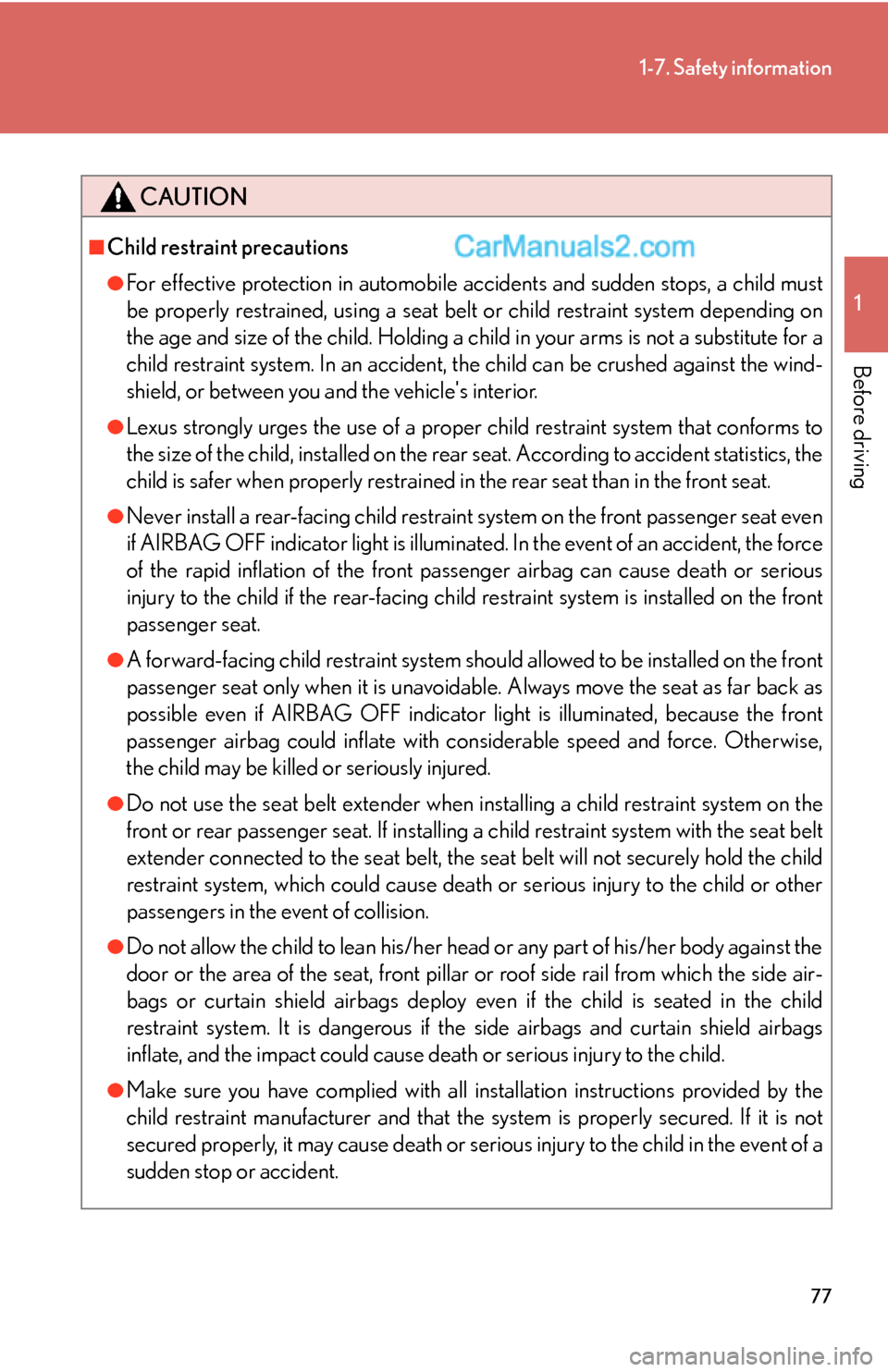Page 4 of 30
60
1-7. Safety information
Airbag system components
Your vehicle is equipped with ADVANCED AIRBAGS designed based
on US motor vehicle safety standards (FMVSS208). The airbag system
controls airbag deployment power for the driver and front passenger. The
driver airbag system consists of the driver seat’s position sensor etc. The
front passenger’s airbag system consists of the front passenger occupant
classification sensor etc.Front passenger airbag
Curtain shield airbags
AIRBAG ON and AIRBAG
OFF indicator lights
Side airbags for the front pas-
sengers
Side and curtain shield airbag
sensors
Curtain shield airbag sensors
Side airbags for the rear out-
side passengers (if equipped)SRS warning light
Driver airbag
Driver's seat position sensor
Knee airbags
Driver's seat belt buckle switch
Front passenger’s seat belt
buckle switch
Airbag sensor assembly
Occupant detection system
(ECU and sensors)
Front airbag sensors
Page 10 of 30

66
1-7. Safety information
CAUTION
■SRS airbag precautions
●The SRS front passenger airbag also deploys with considerable force, and can
cause death or serious injury especially if the front passenger is very close to the
airbag. The front passenger seat should be as far from the airbag as possible with
the seatback adjusted, so the front passenger sits upright.
●Improperly seated and/or restrained infants and children can be killed or seri-
ously injured by a deploying airbag. An infant or child who is too small to use a
seat belt should be properly secured using a child restraint system. Lexus strongly
recommends that all infants and children be placed in the rear seats of the vehicle
and properly restrained. The rear seats are the safest for infants and children.
(→P. 7 5 )
●If the seat belt extender has been con-
nected to the driver's seat belt buckle but
the seat belt extender has not also been
fastened to the latch plate of the driver's
seat belt, the SRS driver's airbag system
will judge that the driver is wearing the seat
belt even though the seat belt has not been
connected. In this case, the driver's airbag
may not activate correctly in a collision,
resulting in death or serious injury in the
event of collision. Be sure to wear the seat
belt with the seat belt extender.
Page 20 of 30
76
1-7. Safety information
Convertible seat
Booster seat
■When the child restraint system is not in use
Leave the child restraint system properly secured on the seat. Do not store the
restraint loosely on a passenger seat or in the trunk.
■Selecting an appropriate child restraint system
Get an appropriate child restraint system for the child. If a child is too large for a
child restraint system, sit the child on a rear seat and use the vehicle's seat belt.
(→P. 3 2 )
Page 21 of 30

77
1-7. Safety information
1
Before driving
CAUTION
■Child restraint precautions
●For effective protection in automobile accidents and sudden stops, a child must
be properly restrained, using a seat belt or child restraint system depending on
the age and size of the child. Holding a child in your arms is not a substitute for a
child restraint system. In an accident, the child can be crushed against the wind-
shield, or between you and the vehicle's interior.
●Lexus strongly urges the use of a proper child restraint system that conforms to
the size of the child, installed on the rear seat. According to accident statistics, the
child is safer when properly restrained in the rear seat than in the front seat.
●Never install a rear-facing child restraint system on the front passenger seat even
if AIRBAG OFF indicator light is illuminated. In the event of an accident, the force
of the rapid inflation of the front passenger airbag can cause death or serious
injury to the child if the rear-facing child restraint system is installed on the front
passenger seat.
●A forward-facing child restraint system should allowed to be installed on the front
passenger seat only when it is unavoidable. Always move the seat as far back as
possible even if AIRBAG OFF indicator light is illuminated, because the front
passenger airbag could inflate with considerable speed and force. Otherwise,
the child may be killed or seriously injured.
●Do not use the seat belt extender when installing a child restraint system on the
front or rear passenger seat. If installing a child restraint system with the seat belt
extender connected to the seat belt, the seat belt will not securely hold the child
restraint system, which could cause death or serious injury to the child or other
passengers in the event of collision.
●Do not allow the child to lean his/her head or any part of his/her body against the
door or the area of the seat, front pillar or roof side rail from which the side air-
bags or curtain shield airbags deploy even if the child is seated in the child
restraint system. It is dangerous if the side airbags and curtain shield airbags
inflate, and the impact could cause death or serious injury to the child.
●Make sure you have complied with all installation instructions provided by the
child restraint manufacturer and that the system is properly secured. If it is not
secured properly, it may cause death or serious injury to the child in the event of a
sudden stop or accident.
Page 22 of 30
78
1-7. Safety information
Installing child restraints
Follow the child restraint system manufacturer's instructions. Firmly
secure child restraints to the rear seats using a seat belt or child restraint
lower anchorages. Attach the top strap when installing a child restraint.
Seat belts equipped with a
child restraint locking mecha-
nism (ALR/ELR belts except
driver’s seat belt) (→P. 32)
Child restraint lower anchor-
ages
Lower anchorages are pro-
vided for the outside rear seats.
(Buttons displaying the location
of the anchorages are attached
to the seats.)
Anchor bracket
(for top strap)
Anchor brackets are provided
for all rear seats.
Page 24 of 30
80
1-7. Safety information
While pushing the child seat down
into the rear seat, allow the shoul-
der belt to retract until the child
seat is securely in place.
After the shoulder belt has
retracted to a point where there is
no slack in the belt, pull the belt to
check that it cannot be extended.
■Forward facing ⎯ Convertible child seat
Place the child seat on the seat
facing the front of the vehicle.
Run the seat belt through the child
seat and insert the plate into the
buckle. Make sure that the belt is
not twisted.
Fully extend the shoulder belt and
then allow it to retract slightly into
the ALR lock mode.
Lock mode allows the seat belt to
retract only.
STEP4
STEP1
STEP2
STEP3
Page 25 of 30
81
1-7. Safety information
1
Before driving
While pushing the child seat into
the rear seat, allow the shoulder
belt to retract until the child seat is
securely in place.
After the shoulder belt has
retracted to a point where there is
no slack in the belt, pull the belt to
check that it cannot be extended.
■Booster seat
Place the child seat on the seat
facing the front of the vehicle.
Sit the child in the child seat. Fit the
seat belt to the child seat accord-
ing to the manufacturer's instruc-
tions and insert the plate into the
buckle. Make sure that the belt is
not twisted.
Check that the shoulder belt is cor-
rectly positioned over the child's
shoulder, and that the lap belt is as
low as possible. (→
P. 3 2)
STEP4
STEP1
STEP2
Page 27 of 30
83
1-7. Safety information
1
Before driving
Ty p e B
Latch the buckles onto the anchor-
ages.
If the child restraint has a top strap, the top strap should be latched onto
the anchorages. (→P. 8 3 )
For owners in Canada:
The symbol on a child restraint system indicates the presence of a lower
connector system.
Child restraint systems with a top strap
Secure the child restraint using a
seat belt or a lower anchors, and
lock the head restraint in place at
the lowest position.
STEP2
Canada only
STEP1